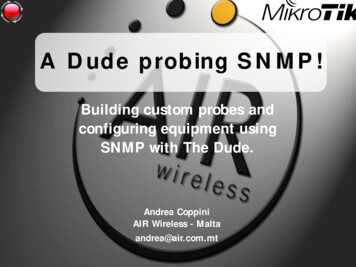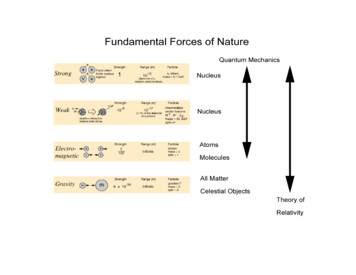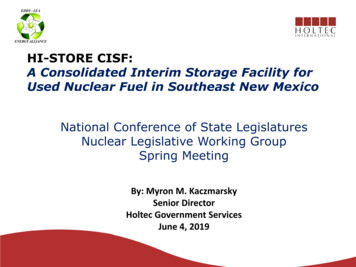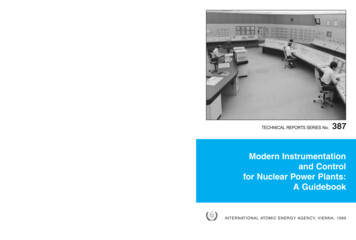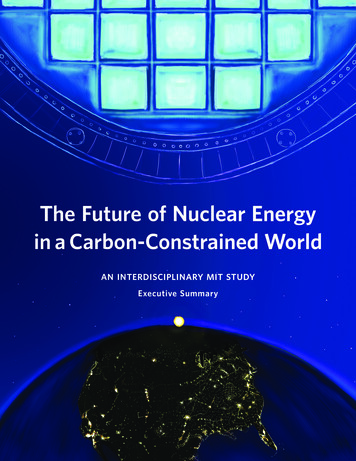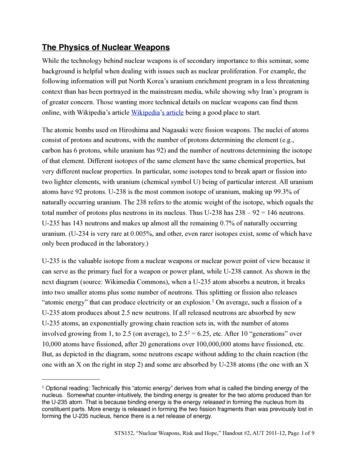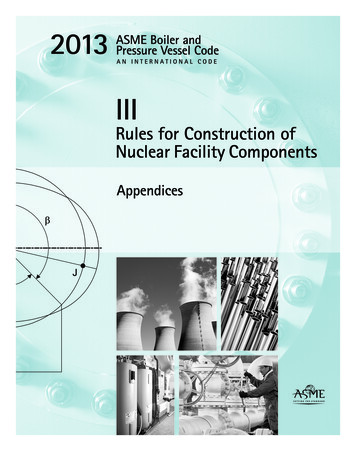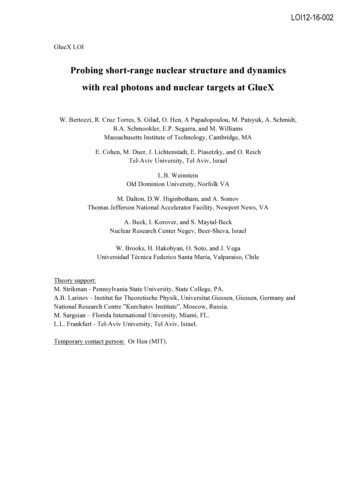
Transcription
LOI12-16-002GlueX LOIProbing short-range nuclear structure and dynamicswith real photons and nuclear targets at GlueXW. Bertozzi, R. Cruz Torres, S. Gilad, O. Hen, A Papadopoulou, M. Patsyuk, A. Schmidt,B.A. Schmookler, E.P. Segarra, and M. WilliamsMassachusetts Institute of Technology, Cambridge, MAE. Cohen, M. Duer, J. Lichtenstadt, E. Piasetzky, and O. ReichTel-Aviv University, Tel Aviv, IsraelL.B. WeinsteinOld Dominion University, Norfolk VAM. Dalton, D.W. Higinbotham, and A. SomovThomas Jefferson National Accelerator Facility, Newport News, VAA. Beck, I. Korover, and S. Maytal-BeckNuclear Research Center Negev, Beer-Sheva, IsraelW. Brooks, H. Hakobyan, O. Soto, and J. VegaUniversidad Técnica Federico Santa María, Valparaiso, ChileTheory support:M. Strikman - Pennsylvania State University, State College, PA.A.B. Larinov - Institut fur Theoretische Physik, Universitat Giessen, Giessen, Germany andNational Research Centre ”Kurchatov Institute”, Moscow, Russia.M. Sargsian – Florida International University, Miami, FL.L.L. Frankfurt - Tel-Aviv University, Tel Aviv, Israel.Temporary contact person: Or Hen (MIT).
Abstract. We propose to measure the A(γ , X) and A(γ , XN recoil ) reactions for A 2H, 4He,12C, 28Si, 40Ca, 48Ca, 54Fe, 111Ag, and 208Pb (where X represents a wide range of baryon-mesonfinal states) using the maximum possible rate of coherent bremsstrahlung photons at Ee 12GeV (i.e. 8-9 GeV real photons) and, if possible, also at Ee 6 GeV during Hall-A parityviolation half energy per-pass running.The data will be used to address the following issues:Possible modification of nucleon structure (as measured by the decomposition to variousFock states) in nuclei. Contributions of protons and neutrons to the high momentum tails of asymmetric nuclei. Transition from mean field to SRC ('Migdal jump'). The reaction of Quasi-Elastic scattering off a single nucleon in SRC pair. Discovering the transition from hadronic to a single parton photon dominance. CT for different particles and reactions.We estimate this measurement will require a total 74 days at 12 GeV: 30 days with a deuterontarget, 14 days with 4He, and 30 days with the other nuclear targets. Pending schedulingconstraints, we could benefit from an additional 30 days at 6 GeV divided in a similar waybetween the different targets. 2
1. Scientific MotivationUnderstanding the interplay between the partonic and nucleonic degrees of freedom in theQCD description of nuclei has been a goal of modern nuclear physics research and of theJefferson Lab physics program in particular [1]. An area of study that clearly combines thetwo is the study of Short-Range Correlations (SRC) in nuclei: pairs of high-momentumnucleons in nuclei whose wave functions considerably overlap [2-10].SRC pairs have important consequences for nuclear structure, hadronic physics, and highenergy physics. Nucleons at short-distance experience a very strong short-range interaction,generating a high-momentum tail to the nuclear wave function. The creation of such a highmomentum tail due to a strong short-range interaction is a universal feature of two-componentFermi systems with a short-range interaction and was shown experimentally to also exist insystems of ultra-cold atomic gases and have wide-ranging implications for their macroscopicproperties [11].The short-range structure of nuclei is therefore a vibrant and important field of research withwide-ranging implications for fundamental nuclear physics and various subfields inastrophysics, atomic, and particle physics. Recent works have shown that short-rangecorrelations inside the atomic nucleus have significant implications on the nuclear symmetryenergy and neutron stars structure, the quark distributions in nuclei (the “EMC effect” ) andthe free (un-bound) neutron structure, energy sharing and correlations in ultra-cold twocomponent Fermi-gases in atomic physics, neutrino-nucleus interactions, and the analysis ofneutron oscillation experiments and more.While the 6 GeV physics program at Jefferson-Lab revolutionized many aspects of ourunderstanding of the properties and importance of SRC pairs in nuclei, there are still manyaspects of correlations we do not understand, ranging from ‘nuclear’ aspects such as thetransition from tensor to central correlations and the dependence of correlations on nuclearasymmetric, to more ‘partonic’ aspects such as the possible connection between short-rangecorrelations and the EMC effect [12-15].This LOI presents a research program for the GlueX detector that will utilize theunique properties of photonuclear reactions off nuclear targets to study properties ofSRC pairs in nuclei, nuclear transparency mechanisms, search for color transparency,and offer new observables to search for modification of the structure of bound nucleons- shedding new light on the quark-gluon structure of bound nucleons.1.2. Nucleon structureThe interplay between partonic and nucleonic degrees of freedom in the QCD descriptionof nuclei can manifest itself in various ways. One of the most prominent ones is the possiblemodification of the partonic structure of nucleons bound in nuclei, due to the strong nuclearinteraction between them. Since the strong nuclear interaction is responsible for the stabilityof atomic nuclei, this modification is fundamental to our understanding of nuclear dynamics.Experimentally, considerable evidence for such modification were first reported over 30 yearsago by the EMC collaboration at CERN who observed a reduction in the Deep InelasticScattering (DIS) cross section per nucleon in nuclei relative to the deuteron (known as the3
EMC effect [12-13]). While numerous theories tried to explain the origin of the EMC effect,and its specific dependence on the nuclear mass number, it still lacks an accepted theoreticalexplanation.In recent years, guided by results of Drell-Yan measurements and high precisionmeasurements of the EMC effect in light and heavy nuclei at SLAC and JLab, it has becomeaccepted that any explanation of the EMC effect must include modification of the boundnucleon structure function in the nuclear medium. Understanding the physical mechanismdriving this modification is the focus of a large ongoing experimental and theoretical effort.There are two main approaches to explain the physical mechanism driving the EMC effect:On the one hand, it was proposed that the strong mean field of the nucleus modifies all thebound nucleons [16]. On the other hand, the strength of the EMC effect was found to belinearly correlated with the relative amount of Two-Nucleon SRC pairs (2N-SRC) in nuclei.This observed correlation indicates that the EMC effect, like 2N-SRC pairs, is relatedpredominantly to the high-momentum (large virtuality / large offshell) nucleons in thenucleus [14-15].To test these models and distinguish between them, new observables are required. In this LOIwe propose to measure the variation in the Branching Ratios (BRs) for hard photonuclearreactions off free (/quasifree) vs. deeply bound nucleons in the deuteron and heavy nuclei.Changes in the measured BRs, which may depend on the momentum transfer, scattering angleand nuclear transparency, will shed new light on the mechanisms of quark-gluon nucleonstructure modification in nuclei. The detailed description of this novel observable follows.The proton (or neutron) is a complex system that can be described in QCD at any givenmoment as a superposition of different Fock states:Eq. 1:proton α PLC PLC α 3qg 3q g α 3qqq 3q qq α 3qπ 3q π . α PLC 2 α 3qg 2 1,where the different brackets represent states of the proton (or neutron) with the correspondingα representing the amplitude of each state. By definition all weights must sum to 1. Theminimal state of the nucleon includes only the 3 valence quarks and is assumed to be small insize and with a reduced strong interaction. Such states are referred to as Point LikeConfiguration (PLC). The other states include more complex configuration involvingadditional gluons, quark-antiquark pairs, pions etc. These states are all components of thewave function of the nucleon.The modified structure of a proton (or neutron) bound in a nucleus can then be represented bya different, decomposition into the same Fock states:Eq. 2:*proton* α *PLC PLC α 3qg3q g α *3qqq 3q qq α *3qπ 3q π .* α *PLC 2 α 3qg 2 . 1where the difference between a free and bound proton is depicted by the difference betweenthe α and α* coefficients in Eqs. 1 and 2. An example of such an effect can be found in the4
‘Point Line Configurations Suppression’ model of Frankfurt and Strikman [17] or the ‘BlobLine Configurations Enhancement’ model of Miller and Smith [18] that propose a possibleexplanation to the EMC effect in which the PLC part of the bound nucleon is different than ina free one.We stress that the Fock space description of bound nucleons is somewhat more complex asnucleons bound in nuclei span various states: e.g. mean-field vs. SRC nucleons, high vs. lowlocal density etc., allowing the α* coefficients to possibly depend on the detailed nuclear stateof the bound nucleon. For example, in the PLC suppression model [17], αPLC*/ αPLC 2 -1 isproportional to the nucleon off-shellness (approximately to the square of the nucleonmomentum) with much smaller modification for configurations close to the average ones.Hence one expects maximal bound nucleon modification in the processes dominated byscattering from small size configurations.We expect that different Fock states will absorb high-energy photons differently and lead to different branching ratios (BR) for various final states (e.g., γ p π Δ or γ p ρ p ).0We propose to use the unique capability of GlueX to measure simultaneously the BRs ofmany decay channels of an excited nucleon following the absorption of a real photon at highmomentum transfer (large t). By measuring these BR for nucleons in a range of nuclei fromdeuterium through lead we will be able to see differences in the Fock state decomposition,and hence the structure, of bound and free nucleons.For a free proton GlueX will measure the branching ratio (BR) for many reactions, includingthe following:Eq. 3:γ p π Δ ρ0 p K Λ K Σ0.By measuring these reactions, and the neutron equivalent, on hydrogen, deuteron and nucleartargets, we can extract the BRs for scattering off free (/quasi-free) vs. deeply bound nucleons.As each reaction is sensitive to a different combination of Fock states, modifying theircontribution to the bound proton will modify their BRs.Current theoretical models do not allow us either to predict the exact change in BRs as afunction of the bound nucleon structure, or to translate the observable BRs to the modified α*coefficients. However, this is a novel observable that allows us to observe or excludedeviations, and to study their dependence on the nucleon momentum and ‘hardness’ ofthe reaction. Any such observation will therefore serve as clear and direct evidence forchanges in bound nucleon structure.On average, differences between a bound and a free nucleon are expected to be small.However, we propose to select specific kinematics, focusing on deeply bound nucleons, thatcould enhance the effect: e.g., selecting hard process with large s, u, and t is expected toemphasize the contribution of the PLC component. Alternatively, detecting the decay5
products along with a high-momentum recoil nucleon (which favors scattering from a nucleonfrom an SRC pair) should also significantly amplify the medium effect to the level observedfor the EMC effect at xB 0.5 – 0.6 that is modification on the scale of 20%. The highmomentum recoil nucleons can best be studied with a deuteron target.In the case of nuclear targets, the measured BRs are not at the photon absorption point butrather following hadron attenuation in the nucleus, which may be different for each channel.To extract the BR at the hard vertex of the quasi free scattering we need to correct for hadronattenuation in the nucleus. We propose to do that by measuring the process on differentnuclei, from deuterium to lead, that span the periodic table. This will yield by itself, as abyproduct, an interesting study of photon and Color Transparency (CT). as well as measurepattern of interaction with media of different mesons. See separate discussion on CT below.1.3. Nuclear structure (SRC)We propose here to utilize the high intensity photon flux and the large acceptance of theGlueX spectrometer to perform a new generation of exclusive and semi exclusive SRCstudies using the A(γ , X) and A(γ , XN recoil ) reactions. Here X stands for the leading mesonand baryon in the different channels listed in Eq. 3 for the proton and the equivalent for theneutron. N recoil stands for a correlated recoil nucleon emitted in the case of photon-absorptionon a nucleon that is part of a 2N-SRC pair.While previous SRC studies using electron beams (i.e. virtual photon exchange) were mainlyprobing a proton in the SRC pair [3-11], the use of a real photon beam opens a new windowto SRC studies by allowing us to probe, for the first time, the neutron in the pairs. The maingoals of this measurement are to study the role of high momentum nucleons in nuclei and therole played by neutrons versus protons. An important advantage of the discussed reactions isthe possibility to select kinematics where the products of interaction with SRC have largerelative momenta leading to a great reduction and simplification of the FSIs.We list below some of the research subjects that can be addressed by SRC studies withGlueX: The isospin structure of the high momentum tail in asymmetric nucleiA unique signature of the dominance of the tensor part of the nuclear interaction at shortdistance is the large ratio of np- to pp-SRC pairs [19], observed directly in measurementsof symmetric nuclei (4He and 12C) [6,10] and indirectly in measurements of asymmetricnuclei (27Al, 56Fe, and 208Pb) [11]. We propose to perform a direct detailed study of SRCpairs in asymmetric nuclei. Mapping the transition from mean field to SRCThe first measurements of SRC pairs in proton scattering data from Brookhaven [20]showed an amazing clear transition between the mean field and the SRC domains, but didnot have enough statistics to precisely map that transition. We will measure the proportion of photo-proton events (e.g., γ p π Δ ) with and without accompanyingrecoil neutrons as a function of the missing momentum. The GlueX recoil neutron6
detection efficiency for neutrons with momentum above 250 MeV/c can yield higherstatistics data that will tell us much more about this intriguing transition.Probing the repulsive core of the NN interactionExperimentally, we know very little about the repulsive core of the NN interaction.Different extractions of the NN potential vary significantly in their description of this partof the interaction and current experimental data has very limited ability to constraintheory. By measuring the ratio of np/pp SRC pairs in nuclei at very high missingmomentum we can probe the transition from the tensor dominant region of the NNinteraction to the repulsive core and, for the first time, probe its properties for nn, pp, andnp pairs.Reaction MechanismThe high intensity real photon beam and the ability to detect many final state reactionsallow us to test the assumed reaction mechanism of quasi-free scattering off a singlenucleon in a pair and a recoil partner. Obtaining consistent results using proton, electron,and photon induced reactions at different kinematics is a key test to support ourunderstanding of the underlying reaction mechanism.1.4. Nuclear Transparency studiesAs stated above, we need to measure the ratio of free to bound nucleon for as many reactionsas possible as a function of A (the nuclear mass number) over a broad range of nuclei toextrapolate reliably to the hard vertex of a ‘bound nucleon’ with reduced corrections fornuclear filtering.However, the search for nuclear transparency of the different particles produced in the hardphoton absorption vertex has a scientific merit by itself. Under the proposed kinematicalcondition theoretical predication show nuclear attenuation with major deviation from thestandard Glauber calculation. These deviations are associated with the nature of therescattering mechanism and the type of particles involve.The ability of the GleuX spectrometer to detect hard exclusive two body processes of thekind:γ A h1 h2 ( A 1)* ,(where h1 and h2 are the two outgoing hadrons) allows addressing a number of importantaspects of nuclear transparency:(a) Photon transparency: At certain kinematical conditions (e.g. low momentumtransfers, t) the photon interacts as a vector meson and at higher –t as single parton.Can we map the transition between these?(b) how different are the interactions of different outgoing mesons and baryons?(c) Color Transparency (CT) is when hadrons are produced in squeezed configurationsand weakly interact with other nucleons on the way out of the nucleus. Can weobserve CT for hadrons? If so, what are the required kinematical conditions forobserving this effect?7
In soft intermediate-energy photohadron production processes the photon is usuallytreated as superposition of hadronic states of moderate masses. In hard processes(high energy, large momentum transfer) these states are suppressed by a factor s-1 ascompared to the single parton - a photon. Scattering off nuclei provides a sensitiveprobe of the transition between these soft and hard behaviors. The single photonpenetrates the nucleus up to the hard interaction with less interaction. The effectivecoherence length in this case is essentially infinite and the photon can interact with allnucleons near the back surface of the nucleus producing a pair of hadrons which canescape without absorption, leading to a σ A 2 / 3 dependence. In contrast, in thehadronic state only the rim of the nucleus contributes i.e. the transparency is lower,the A dependence is different ( σ A1 / 3 ), and the Glauber approximation can describethe process. See in Figure 1 the calculation of [21] to demonstrate the expected largesize of the effect.Assuming the transition to be at about t 2 GeV2 [21] it would be feasible to studythis transition for different channels. It may depend on quark composition (compare πand η) and the spin of the final state (compare π and ρ).The available data show substantial differences between the nuclear attenuation ofprotons and mesons (π, ρ) produced in hard processes. The Hall D beam line and theGlueX detector allow us to study large numbers of hard exclusive reactions with alarge variety of different emerging particle (η, φ, K , K *, Λ ). Comparing differentinelastic reactions in different nuclei at kinematical conditions that are optimal forobserving CT and others kinematics will allow to constrain our understanding of theunderline dynamics of these rescattering processes.These measurements also allow us to determine an effective cross section for thescattering of the outgoing particles with a nucleon (σ ηN , σ ΦN .) . The additive quarkmodel describes well the ratio between the πN, KN, and NN cross sections but notnecessary the other meson-nucleon cross sections. Some of these can be extractedfrom the GlueX photo production data. This data will lead to a better understanding ofthe process which cannot be well described by perturbative simple quark counting.The sensitivity to the effective rescattering cross section is demonstrated in Figure 2where the transparency ratio to a standard transparency (like for the A(γ , π p) ) isshown as a function of the effective cross section.Figure 1: Transparency for the A(γ , π p) reaction calculated with a Glauber modelwith and without photon attenuation. See [21] for details.8
Figure 2: The ratio of transparency for the A(γ , h N ) reaction to the transparency forA(γ , π p) as a function of the effective rescattering cross section, σ hN . The inelasticσ π N was assumed to be 20 mb.High energy and large angle scattering are natural process to look for CT effects. Thehard process emphasizes the contribution of the minimal Fock state with a reducedinteraction. The photon allows the vertexes to be distributed all over the nuclearvolume and the transparency limit to detected events only if the final state particlessucceed to emerge from the nucleus. In the possible kinematics allowed and with theexpected statistics of GlueX, Ref [21] predicts a large effect due to CT, i.e., ameasureable difference from Glauber calculations.For example, Figs 3 and 4 show calculations by Larionov and Strikman [21] for theA(γ , π p) reaction as a function of the photon energy for fixed 90 degree cm anglescattering and as a function of t for fixed incident photon energy.To summarize, the study of the nuclear transparency of the different particlesproduced in the hard photon absorption vertex has a scientific merit by itself. Underthe proposed kinematical conditions, a major deviation from the standard Glaubercalculation and perturbative quark additive predictions are expected. These deviationsare associated with the nature of the rescattering mechanism and the type of therescattered particles. The simultaneous measurement of a few reaction channels andthe ability to create ratios and supper ratios of transparencies will allow us to studythese processes with small systematic and statistical uncertainties and to stronglyconstrain the theoretical interpretation. These measurements will complement theapproved 12 GeV experiment to study CT in pion and ρ- electroproduction as well asin quasielastic proton knockout.9
Figure 3: The of transparency for the A(γ , π p) reaction as a function of the photonenergy for 90 degree cm scattering angle.Figure 4: The of transparency for the 197 Au (γ , π p) reaction as a function of themomentum transfer ,-t. for 10 Gev photon energy.10
2. The proposed measurement:2.2. KinematicsThe kinematical distributions and expected rates were calculated for the various reactionsbased on measured photonuclear cross-sections and a dedicated Monte-Carlo event generator.In the following we present the calculation method, and show the resulting kinematicaldistributions for one reaction. Following that we present rates for all other reactions and pointto significant changes to the kinematical distributions when needed.The steps of the calculation are as follows:1. Choose a photon randomly from the GlueX photon energy distribution and an initialnucleon randomly from a correlated Fermi-Gas model.2. Boost to the nucleon rest frame and calculate the cross-section for the photon energyin this frame. 3. Boost to the c.m. frame and calculate the scattering for angles of 50 θ cm 130Enforce a ‘hard reaction’ by only keeping events with t , u 3 GeV2. 4. Weight the event using the cross-section obtained in step 2.The cross-section for a stationary nucleon is extracted by fitting data for 90o scattering in thec.m. with s 6.25 GeV2 assuming factorization of the s and c.m. angle dependence, i.e.!"!# %.'. 𝐶 𝑠 ,- 𝑓(𝜃1.2. ), where C is a free fit parameter and f was extracted from SLACdata assuming 𝑓 906 1 [22], see Fig. 5. Figs. 6-8 show kinematical distributions for γ n π p at θ cm 90 10 where the reactionis done off a standing nucleon, a mean-field nucleon, and a nucleon from an SRC pairrespectively. GlueX was designed to measure such reactions off standing nucleons. As can beseen, the kinematical distributions for the case of scattering off nucleons bound in nuclei issimilar and therefore we expect GlueX to offer high acceptance for these reactions. Differentfinal states are expected to have similar kinematical distributions.Fig. 9-11 show the same as Fig. 6-8 only with no restriction on the c.m. angle. Fig. 12 showsthe angular distribution of the SRC recoil partner nucleon.11
Figure 5: The s dependence of the photonuclear cross-section at 90o in the c.m. (left) and itsdependence on the c.m. angle (right). We extract the cross-section by fitting the s dependenceat high-s, after the low-s oscillations appear to the over. Figures were adapted from [22]. Figure 6: Kinematical distributions for the final state particles in the γ n π p reaction forscattering off standing nucleon at 90o in the c.m.12
Figure 7: Same as Fig. 6 for scattering off mean-field nucleons in the nucleus (i.e. nucleonswith k kF).Figure 8: Same as Fig. 6 for scattering off SRC nucleons in the nucleus (i.e. nucleons with k k F)13
Figure 9: Same as Fig. 6 for all c.m. scattering angles.Figure 10: Same as Fig. 7 for all c.m. scattering angles.14
Figure 11: Same as Fig. 8 for all c.m. scattering angles.Figure 12: The angular distribution of the recoil nucleon when scattering off SRC pairs in thenucleus.15
2.3. Acceptance and Detection EfficienciesAs mentioned, the GlueX detector was designed to have very large acceptance of highmomentum forward going charged particles emitted in the A(γ , X) reaction. However, whenscattering off SRC pairs we are interested in the coincidence detection of a recoil nucleon inthe backward hemisphere (see Fig. 12). To study the acceptance of the recoil proton / neutronwe ran Geant4 simulations of the GlueX detector for recoiling nucleons at a wide range ofangles and recoil nucleon momenta.Fig. 13 shows the acceptance and detection efficiency for recoiling protons for 3 differentvertex positions – at the center and two ends of the 30 cm long hydrogen target. As can beseen, the detection efficiency is very high up to 140o in the lab and can extend up to 160owhen the target is placed downstream. Fig. 14 shows the vertex reconstruction resolution,showing we can separate solid target foils with a distance of 1 cm.Fig. 15 shows the neutron detection efficiency as a function of the neutron momentum andangle. As can be seen, neutrons with momentum as low as 200 MeV/c can be detected withefficiency of 20% and even more than that, over a large range of recoil angles.Figure 13: The detection efficiency for recoiling protons in GlueX as a function of the recoilangle and momentum for 3 different vertex locations.16
Figure 14: The vertex reconstruction resolution for recoiling protons a various recoil angles.Figure 15: Same as fig. 13 for neutrons.17
2.4. Rates The rate calculations were done for the γ n π p reaction, using the simulation presented insection 2.2. We assume 6 beam days with a photon flux of 5x107 sec-1 on a 2 g/cm2 nucleartarget. Based on the acceptance simulations presented in section 2.3 we assume 75% detectionefficiency for the leading baryon and meson and 80% for the recoil nucleon. We also assumea reduction in the rate of 50% due to transparency of the leading baryon and meson and another 50% for the recoil nucleon. We note that we choose the γ n π p reaction as it hasone of the smallest cross-sections and therefore can serve as a lower bound on the expectednumber of events from the other reactions that will be measured simultaneously.Figure 16 shows the t distribution for mean-field and SRC nucleons, with and without a cut on θ cm 90 10 . As can be seen, without a cut on the c.m. angle, over 100 events per 1GeV2 bin in t can be measured over a wide t range. For 90o scattering and/or scattering offSRC nucleons the expected statistics is significantly lower but integrating over t still providesenough statistics to study the reactions of interest.Figure 16: The count rate as a function of t for scattering off a nuclear target for mean-field(left) and SRC (right) nucleons.18
3. SummaryWe propose to measure the A(γ , X) and A(γ , XN recoil ) reactions (where X represents a widerange of meson-baryon final states) for A 2H, 4He, 12C, 28Si, 40Ca, 48Ca, and 54Fe, 111Ag, and208Pb using the maximum possible rate of coherent bremsstrahlung photons at Ee 12 GeV(i.e. 8-9 GeV photons) and, if possible, also at Ee 6 GeV during Hall-A parity-violation halfenergy per-pass running.The data will be used to address the following issues: Possible nucleon decomposition modification in nuclei.Proton/neutron in asymmetric nuclei momentum tail.Transition from mean field to SRC (Migdal jump).The reaction of Quasi-Elastic scattering of a single nucleon in SRC pair.Discovering transition from resolved to unresolved photon dominance.CT for different particles and reactions.We estimate this measurement will require a total 74 days at 12 GeV: 30 days with a deuterontarget, 14 days with 4He, and 30 days with nuclear targets. Pending scheduling constraints, wecould benefit from an additional 30 days at 6 GeV divided in a similar way between thedifferent targets.19
References:[1] The 2015 long range plan for nuclear science, http://science.energy.gov/np/nsac/[2] “Hard nuclear processes and microscopic nuclear structure”, L. Frankfurt, M. Strikman,Phys. Rep. 160, 235–427 (1988).[3] "Observation of nuclear scaling in the A(e,e′) reaction at xB 1", K. Sh. Egiyan et al., Phys.Rev. C 68, 014313 (2003).[4] “Measurement of Two- and Three-Nucleon Short-Range Correlation Probabilities inNuclei”, Egiyan et al., Phys. Rev. Lett. 96, 082501 (2006).[5] “Investigation of Proton-Proton Short-Range Correlations via theR. Shneor et al., Phys. Rev. Lett. 99, 072501 (2007)12C(e,e′pp) Reaction”,[6] “Probing Cold Dense Nuclear Matter”, R. Subedi, et al., Science 320, 1426 (2008).[7] “Two-Nucleon Momentum Distributions Measured in 3He(e,e′pp)n”, R.A. Niyazov, Phys.Rev. Lett. 92, 052303 (2004).[8] “Tensor Correlations Measured in 3He(e,e′pp)n”, H. Baghdasaryan, L.B. Weinstein, andthe CLAS Collaboration, Phys. Rev. Lett. 105, 222501 (2010).[9] “New Measurements of High-Momentum Nucleons and Short-Range Structures inNuclei”, N. Fomin, et al., Phys. Rev. Lett. 108 (2012) 092502.[10] “Probing the Repulsive Core
energy and neutron stars structure, the quark distributions in nuclei (the “EMC effect” ) and the free (un-bound) neutron structure, energy sharing and correlations in ultra-cold two-component Fermi-gases in atomic physics, neutrino-nucleus interactions, and
